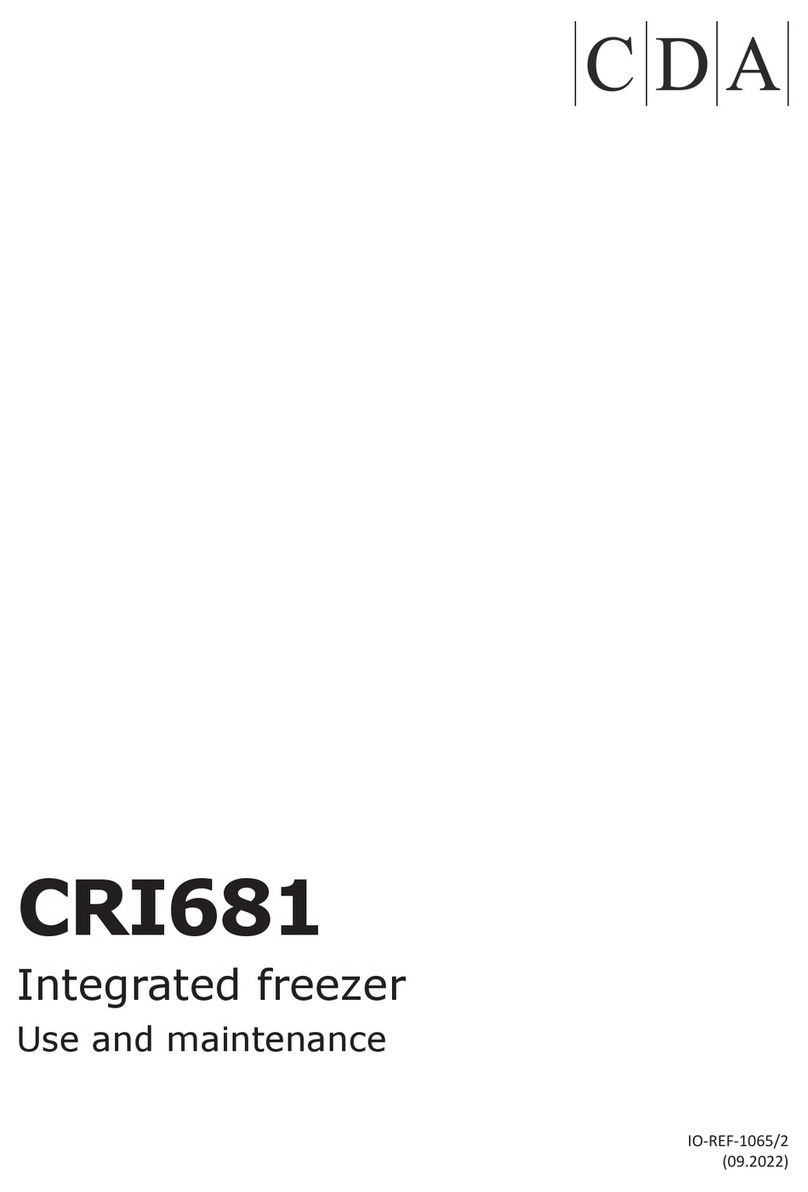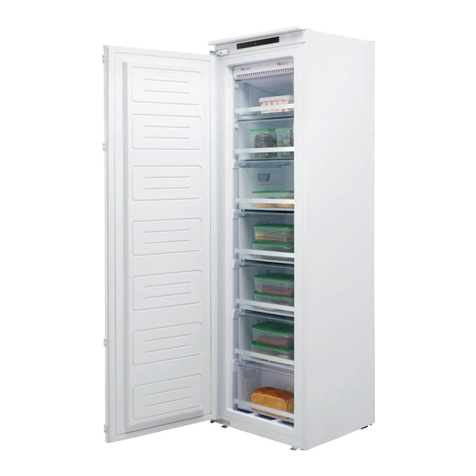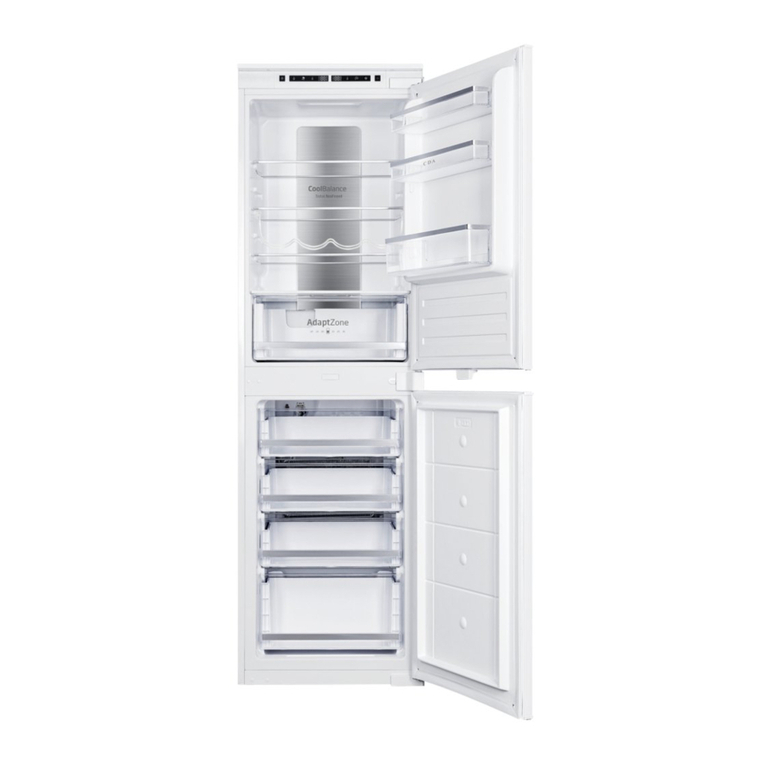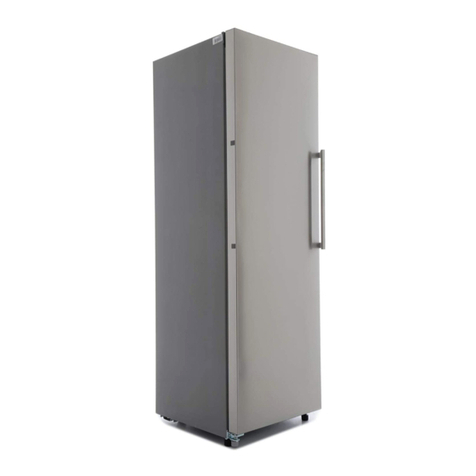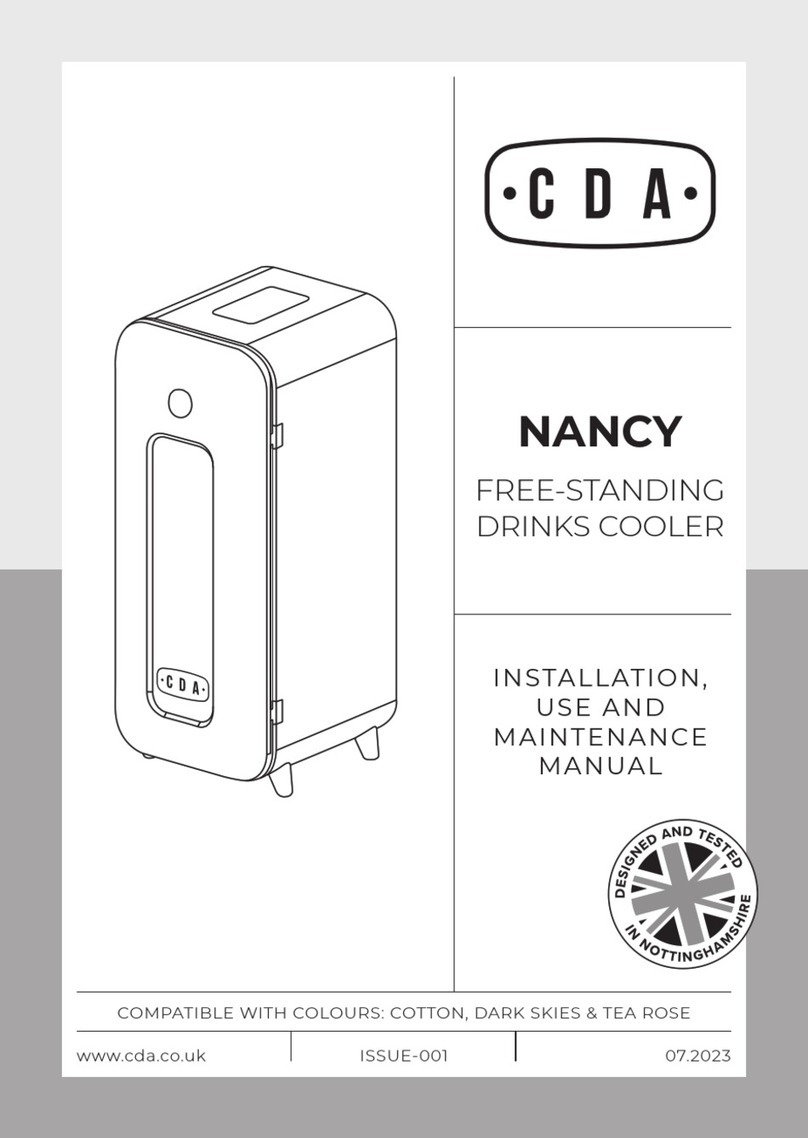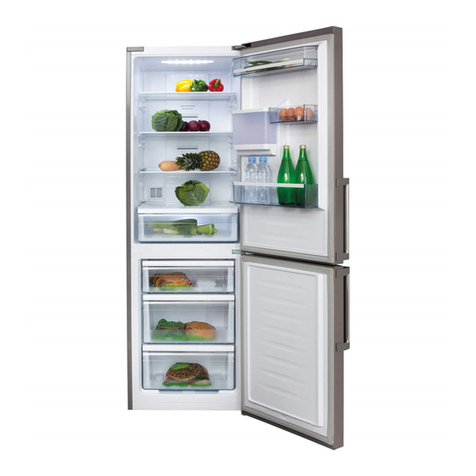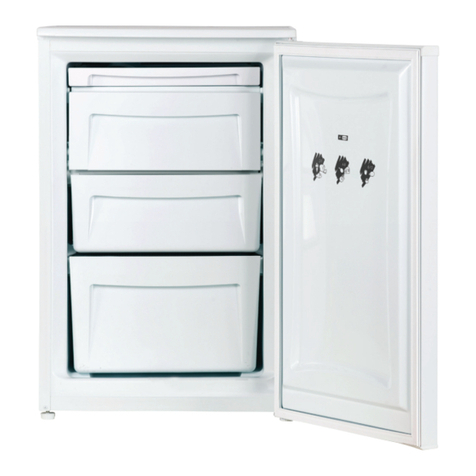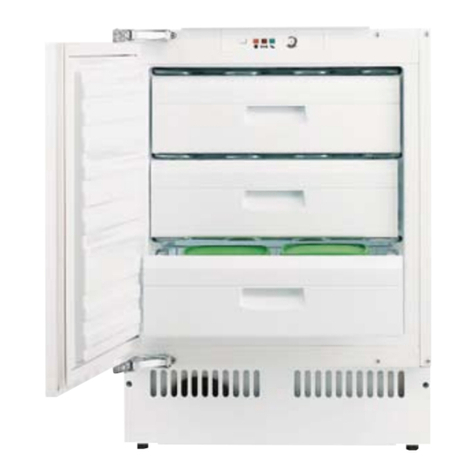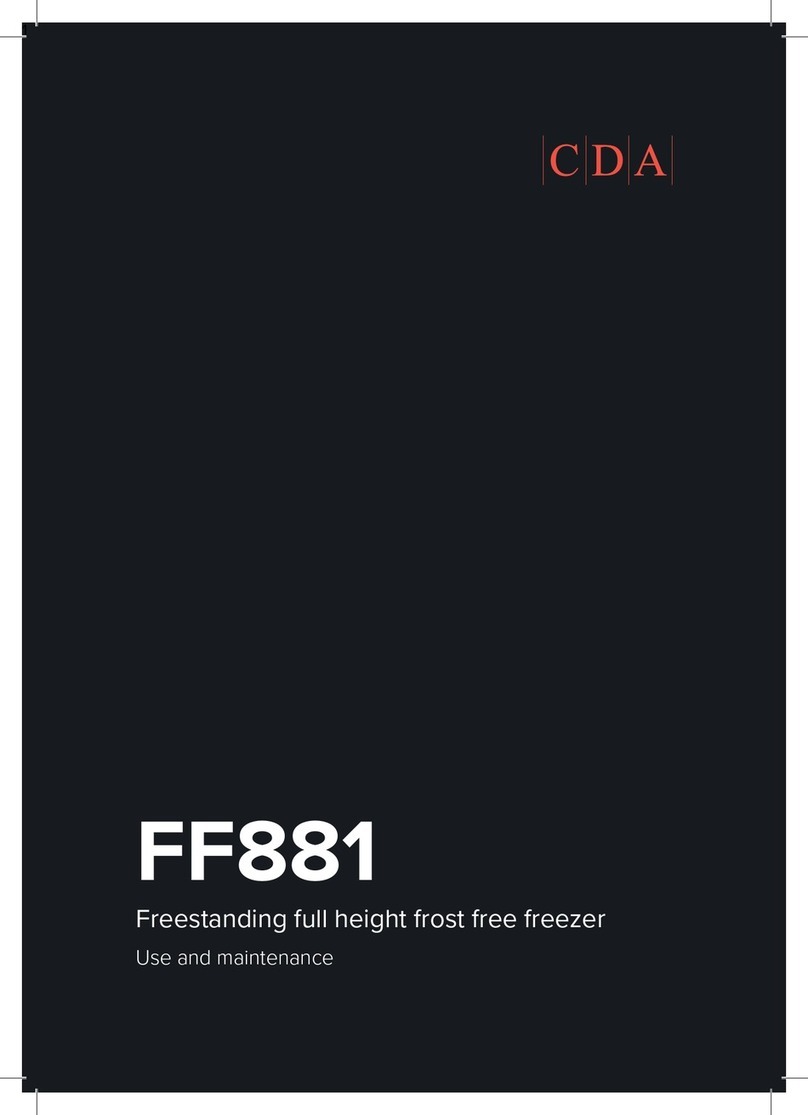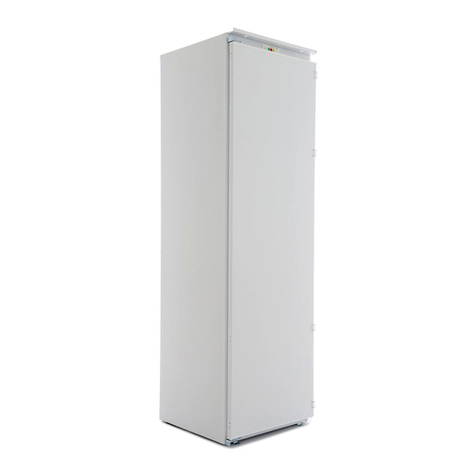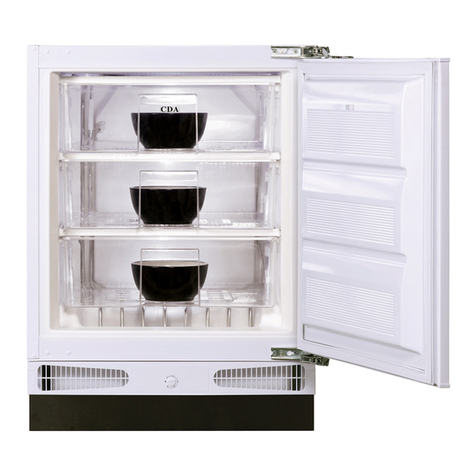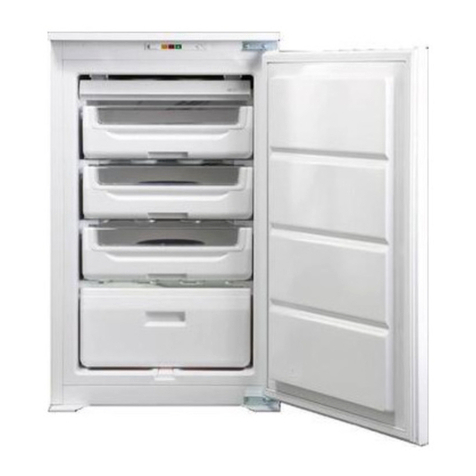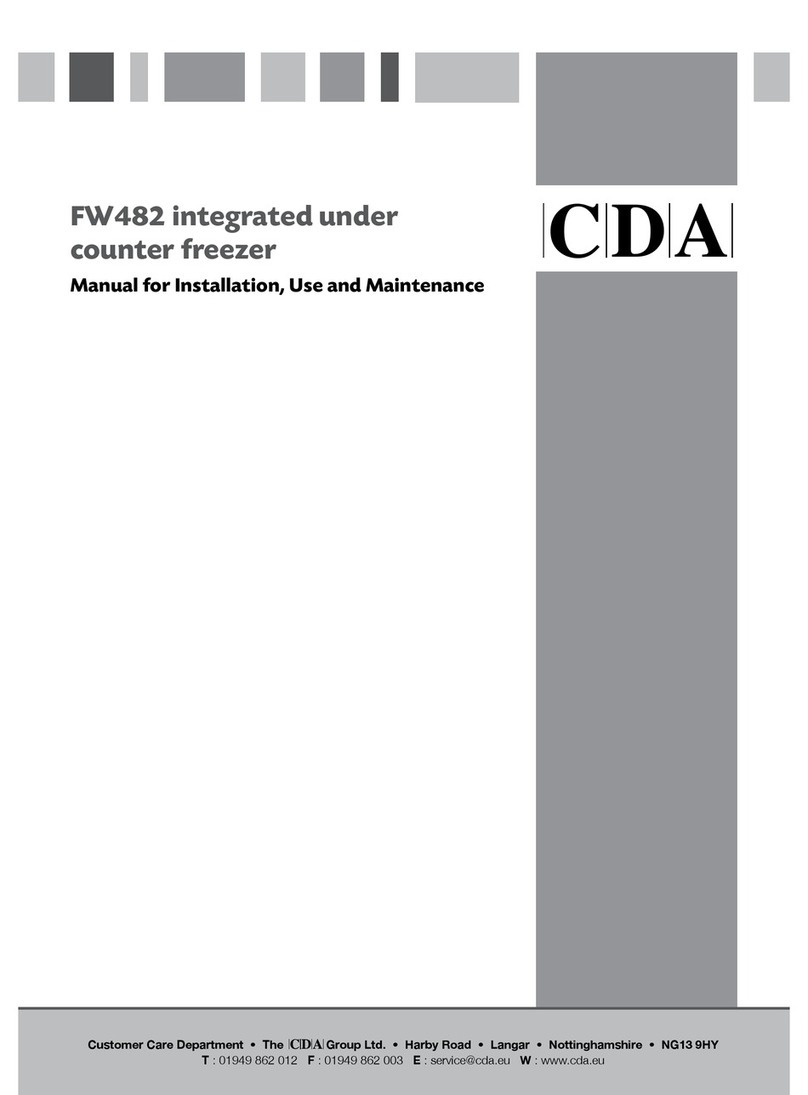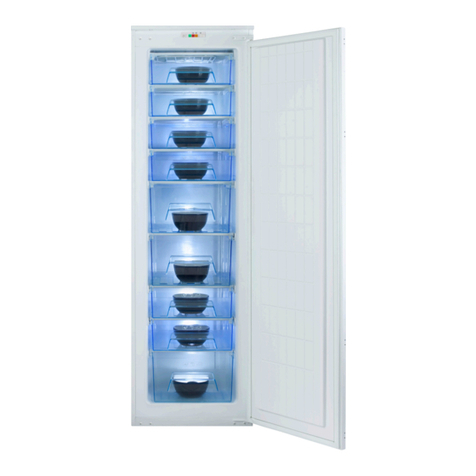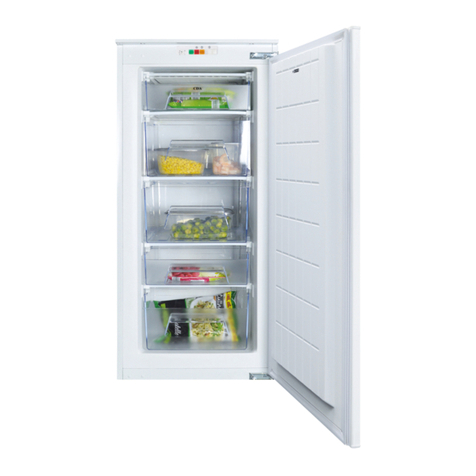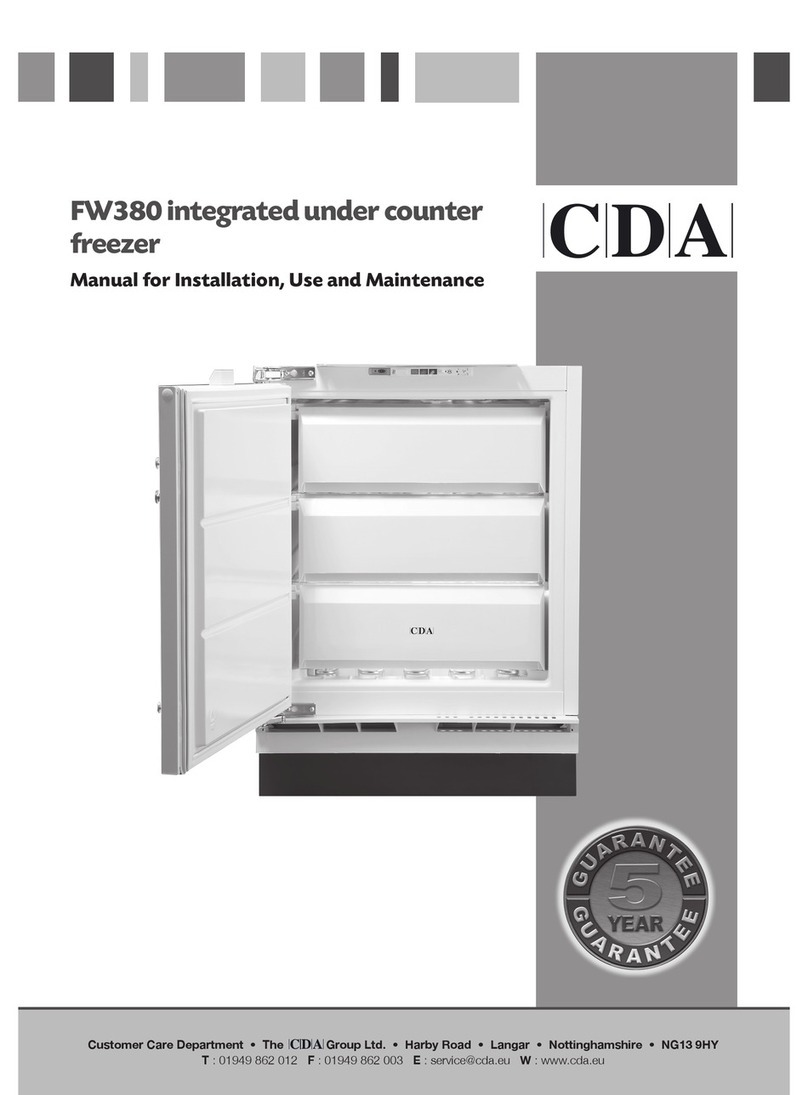CDA FW927 Installation and operating instructions

FW925
FW927
Integrated fridge freezer
Installation, use and maintenance

2
Contents:
3 Important information
5 Important notes
5 Before first use
6 Important notes on use of the fridge
7 Important notes on use of the freezer
8 Crisper drawer humidity adjustment
9 Storage
10 Control panel
11 Care and cleaning
12 Defrosting the fridge
12 Defrosting the freezer
13 Troubleshooting
15 Installation preparation
15 Ventilation requirements
17 Installation into the cabinet
18 Mounting the fascia doors
20 Reversing the appliance doors
21 Electrical information
23 Climate range
24 Practical tips
25 Warranty and service

3
Important
The manufacturer cannot be held responsible for injuries or losses
caused by incorrect use or installation of this product. Please note
that we reserve the right to invalidate the guarantee supplied with this
product following incorrect installation or misuse of the appliance.
This appliance is not designed to be used by people (including
children) with reduced physical, sensorial or mental capacity, or
who lack experience or knowledge about it, unless they have had
supervision or instructions on how to use the appliance by someone
who is responsible for their safety.
Under no circumstances should any external covers be removed for
servicing or maintenance except by suitably qualified personnel.
Appliance information:
Please enter the details on the appliance rating plate below for
reference, to assist CDA Customer Care in the event of a fault with
your appliance and to register your appliance for guarantee purposes.
Appliance Model
Serial Number
EU Declarations of Conformity:
This appliance has been designed, constructed and marketed in
compliance with safety requirements of EU Directive 2014/35/EU (Low
voltage) and requirements of EU Directive 2014/30/EU (EMC).

4
This appliance has been manufactured to the strictest standards and
complies with all applicable legislation, including Electrical safety (LVD)
and Electromagnetic interference compatibility (EMC). Parts intended
to come into contact with food conform to 1935/2004/EC.
This refrigeration appliance is intended for use as a built-in appliance.
IMPORTANT INFORMATION FOR CORRECT DISPOSAL OF THE
PRODUCT IN ACCORDANCE WITH EC DIRECTIVE 2012/19/EU.
At the end of its working life, the product must not be disposed of as
urban waste. The refrigeration system contains insulating gases and
refrigerants, which require specialised waste disposal. The valuable
materials contained in this appliance can be recycle. It must be taken
to a special local authority dierentiated waste collection centre or to
a dealer providing this service.
Before disposing of an old appliance, remove the door seals etc. to
reduce the risk of child entrapment.
Disposing of a household appliance separately avoids possible
negative consequences for the environment and health deriving from
inappropriate disposal and enables the constituent materials to be
recovered to obtain significant savings in energy and resources. As a
reminder of the need to dispose of household appliances separately,
the product is marked with a crossed-out wheeled dustbin.

5
Important
•Never store inflammable or explosive items and strong corrosive
acids or alkalis in the appliance.
•This is a household appliance, which is produced in accordance
with the national standard. It is intended for food storage only, not
for storage of blood, medicine and biological products.
•To prevent risk of fire, keep the appliance away from petrol or any
other inflammables.
•To prevent risk of electromagnetic interference or other accidents,
do not place a microwave oven on top of the refrigerator or use
any electric appliance inside the refrigerator.
•Do not allow children to play with or near the appliance.
•The internal surface of freezer compartment is very cold when the
appliance is running. Do not touch the surface especially when
hands are wet.
•Do not splash water onto the appliance. Keep it away from places
of high humidity that may have adverse eect on the electric
insulation performance.
•This appliance is designed to be used in ambient temperatures
between 10 and 32˚C. Use outside of this range may cause the
appliance to fail.
Before first use
You must allow the fridge to settle for at least twenty four hours
prior to switching the power on.
It is recommended that you clean the interior of the appliance prior to
first use, using a solution of bicarbonate of soda and warm water and
then thoroughly drying the interior.

6
The fridge may have an odour to it at first use. This will disappear as
the appliance cools.
Please note:
The appliance will start on temperature setting 3 and work
continuously until it comes down to the correct temperature. If the
appliance is switched o, you should allow five minutes before
switching it on again to prevent unnecessary damage to the
compressor.
Never store inflammable or explosive items and strong corrosive
acids or alkalis in the appliance.
This fridge cools your food by making the inside back of the cavity
cold. It is normal for frost to build up on this surface; it then dissipates
and drains through a small drain at the bottom, where it evaporates
harmlessly. The presence of frosting at the back is not a malfunction
of the fridge.
Fridge use
•Never put liquids in the refrigerator uncovered.
•Never put hot foods in the refrigerator. Warm food should be
allowed to cool to room temperature before being put into the
refrigerator.
•Nothing should rest against the rear wall of the refrigerator, as this
will cause frost and possible condensation problems which will be
dicult to remove.
•Make sure food is clean and any extra water is wiped away before
putting into the fridge.
•Wrap or cover food before putting into the fridge. This will help

7
prevent the loss of moisture, keep food fresh and avoid
unpleasant odours.
• Sort foods prior to storing. Any foods to be used soon should be
stored at the front of the shelf to prevent deterioration caused by
the door being open for prolonged periods.
•Do not overfill the fridge. There should be sucient space
between the foods to allow the cool air to circulate.
•Thawing frozen foods in the fridge compartment will help to keep
the temperature low and save energy.
•Never store raw meats on shelves above cooked meats or other
produce. This will help to prevent juices from raw meat contaminating
other foodstus.
Freezer use
•The freezer compartments are designed to store only frozen food.
•Never put hot or warm foods in the freezer, allow them to cool fully
before putting them into the freezer.
• Follow the instructions on the food packaging for storage of frozen
food. If no information is provided, foods should not be stored for
more than three months after the purchase date.
•Store food in small packages (ideally less than 1kg). This reduces
the freezing time and improves the quality of the food after
thawing.
•Wrap food before putting into the freezer. To stop the wrapping
sticking together, ensure it is dry.
• Label the food before freezing with information including type of
food and dates of storage and expiry.

8
•Once food is thawed, it must not be refrozen. Only defrost as
much food as is required to prevent wastage.
• Bottled or canned drinks should not be stored in the freezer
compartments as they could explode.
•The maximum amount of fresh food that can be frozen within a 24
hour period is 4.5 kg for the FW925 and 3.0 kg for the FW927.
•Do not attempt to freeze more than the maximum amount.
•To freeze fresh food more quickly, switch on the super freeze
function a few hours prior to placing the food in the freezer.
Note: If the appliance does not have a freezer compartment ( )it is
not suitable for freezing foodstus.
Crisper drawer humidity adjustment
The crisper drawer within this appliance features a humidity level
adjustment slider. Vegetables and similar produce that are subject to
wilting (e.g. arugula, spinach leaves, herbs such as basil etc.) should
be kept in the crisper drawer and the adjustment slider kept closed
(fully to the left - high). By keeping the adjustment slider closed, water
vapour is held in the drawer and subsequently greens are kept crisper
and fresher for longer.
By contrast, fruits that are susceptible to rotting should be stored in
the crisper drawer with the humidity adjustment slider fully open (to
the right - low). This will allow gases, emitted by certain produce and
that accelerate the rotting process, to exit the crisper drawer. The
drawer is marked high and low with vegetable and fruit symbols to aid
you.

9
Storage
The fridge section is for short term food storage. Although low
temperatures can be maintained, extended periods of food storage is
not recommended.
As the cold air circulates within the fridge, the temperature can vary
between the dierent sections. As such, foods should be stored in
dierent sections according to type. Section 7 is the coldest part of
the fridge.
1. Butter, cheeses etc.
2. Food in jars and bottles
3. Drinks, e.g. milk
4. Cooked food
5. Yogurts, preserves etc.
6. 75cl bottles or ready meals etc.
7. Fresh meat and fish
8. Fruit and vegetables
The fridge shelves can be moved
according to the storage requirements
within the fridge section. To move the
shelf, lift up the rear section and then
pull it outwards. To replace, slide the
shelf back into the slot, and then lower
the rear section.
The wine racks can be deployed or
withdrawn as desired.
Fig. 1
Fig. 2
6
7
8
4
5
1
3
2
FW927

10
Control Panel
A. Refrigerator temperature adjustment sensor
This button is used to adjust the temperature within the fridge. Press
this sensor once to activate adjustment, and then as many times as
necessary until the desired level is selected. The settings range from 1
to 6 with 1 being the warmest and 6 being the coldest.
Please note: Where possible, avoid having the temperature setting on
6 all of the time. This well help to alleviate strain on the compressor
and refrigeration system.
B. Refrigerator temperature setting display
This display will illuminate the current temperature setting. Adjusting
the temperature will cycle through this display.
Please note: You do not use numbers 1 to 6 to change the
temperature. Instead, use the refrigerator temperature adjustment
sensor (A).
C. Power button
Use this sensor to switch the appliance on and o (standby mode).
The sensor will be illuminated when the appliance is o.
Fig. 3
A B C
This manual suits for next models
1
Table of contents
Other CDA Freezer manuals

